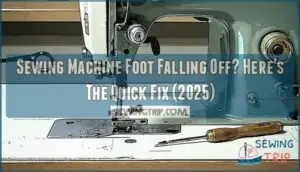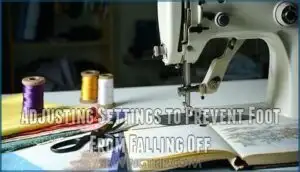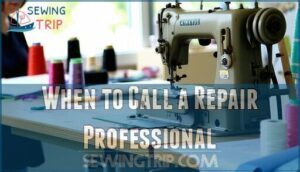This site is supported by our readers. We may earn a commission, at no cost to you, if you purchase through links.
 When your sewing machine foot keeps falling off, you’re likely dealing with a loose attachment screw that needs tightening, a cracked or damaged presser foot, or a worn presser bar that’s lost its grip.
When your sewing machine foot keeps falling off, you’re likely dealing with a loose attachment screw that needs tightening, a cracked or damaged presser foot, or a worn presser bar that’s lost its grip.
Start by checking the screw tightness—use the correct screwdriver size and tighten snugly without overdoing it.
If the screw’s secure but your foot still won’t stay put, inspect the foot itself for hairline cracks or warped metal that compromises its attachment.
A faulty presser bar can also cause chronic detachment issues, especially if the shank shows wear or the bar has bent slightly.
Most sewists can fix these problems in minutes with basic tools and observation skills.
Table Of Contents
Key Takeaways
- Check your attachment screw first – you’ll find that most foot problems stem from a loose screw that needs tightening with the right screwdriver size
- Inspect your presser foot for damage – look for hairline cracks, warped metal, or bent areas that compromise the foot’s ability to stay attached securely
- Match your fabric type to the proper pressure settings – heavy fabrics need more pressure, while delicate materials require gentler settings to prevent foot slippage
- Replace worn components promptly – do not ignore rattling sounds, excessive vibration, or repeated detachment, as these signal that it’s time for new parts before causing bigger problems
Why Does My Sewing Machine Foot Fall Off?
When your sewing machine foot keeps falling off, you’re dealing with one of three main culprits: a loose screw, a broken foot, or a faulty presser bar.
Don’t worry—this common frustration usually has a simple fix that takes just a few minutes to resolve.
Loose Screw
Most loose presser foot screws happen because we forget to check them regularly.
Here’s how to tackle this common culprit:
- Check screw tightness before each sewing session
- Use correct screw size screwdriver to avoid creating a stripped screw
- Apply gentle tightening technique – snug but not overtightened
- Schedule regular checks monthly to catch loosening early
- Consider screw replacement if threads are worn
A wobbly sewing machine foot throws off your whole rhythm, making precise stitching nearly impossible.
A shaky presser foot ruins your stitching precision and throws off every seam.
Fabric puckering may indicate improper foot pressure.
Broken Foot
Sometimes your sewing machine foot looks perfectly fine until closer inspection reveals hairline cracks or subtle bending that compromises attachment.
These foot material weaknesses cause presser foot detachment during sewing. Start with thorough crack inspection—examine the entire foot under good lighting, checking mounting areas where stress concentrates.
Bending issues often occur near the shank attachment point. When replacement becomes necessary, follow this replacement guide: match your machine’s shank compatibility requirements exactly.
For those needing replacements, it’s useful to check out a site for sewing foot products. Remove the broken foot carefully, install the new presser foot, and test on fabric scraps.
Proper sewing machine foot repair prevents costly damage to your machine’s internal mechanisms, ensuring a longer lifespan and better performance.
Faulty Presser Bar
Behind every presser foot detachment lies a potential faulty presser bar—the unsung hero holding everything together.
Behind every presser foot detachment lies a potential faulty presser bar—the unsung hero holding everything together
When shank wear or presser damage occurs, your foot stability vanishes faster than thread through fabric.
A loose screw or bent bar creates chaos, causing your presser foot loose episodes, which can be solved by bar replacement that restores proper bar alignment and ends your sewing machine’s rebellious streak, ultimately solving chronic detachment issues.
How to Properly Attach The Sewing Machine Foot
Now that you know what causes a presser foot loose situation, let’s get your sewing machine back on track. Proper foot attachment isn’t rocket science, but it does require following the right steps to avoid a foot installation error.
Start by turning off your machine and raising the needle to its highest position. This gives you clear access to work without any surprises. Next, lift the presser foot lever completely – this releases tension and makes the whole process much easier.
Here’s your step-by-step attachment process:
- Check shank compatibility – Verify your replacement foot matches your machine’s shank type (low, high, or slant)
- Perform holder inspection – Clean any lint or debris from the presser foot holder before installation
- Focus on foot alignment – Position the foot’s pin directly under the shank opening for proper engagement
- Practice secure screwing – Tighten the attachment screw firmly but don’t overdo it (think snug, not Superman-tight)
Many machines use snap on feet for easy changes. Lower the presser foot lever slowly until you hear or feel the pin snap into place. Always finish with testing attachment by gently tugging the foot – it shouldn’t budge if properly installed.
Adjusting Settings to Prevent Foot From Falling Off
You can prevent your sewing machine foot from falling off by matching your fabric type to the correct foot and adjusting the pressure settings accordingly.
The wrong combination of thick fabric with improper pressure can cause the foot to slip from its track, while using the right thread weight helps maintain consistent tension that keeps everything secure, which is crucial for preventing the foot from falling off and ensuring a smooth operation.
Fabric Type
Different fabric types can cause presser foot loose issues if you don’t match them properly.
Fabric Weight matters most – heavy materials like denim need sturdy attachments, while Delicate Fabrics require gentle handling.
| Fabric Type | Common Issues |
|---|---|
| Knit Fabrics | Stretching causes foot attachment issue |
| Thick Fabrics | Creates pressure that loosens foot press |
| Slippery Materials | Fabric Texture makes sewing foot problem worse |
Check fabric compatibility before starting your project to prevent loose foot press problems.
Thread Type
Your thread choice can make or break your sewing project. Thread Material matters more than you’d think—cheap thread creates thread tension issues that stress your presser foot.
Here’s what works best:
- Polyester thread handles heavy fabrics without snapping, reducing machine strain
- Cotton thread flows smoothly through delicate materials like silk and lace
- Specialty Threads require Thread Compatibility checks—metallic threads need special needles
Match your Thread Weight to fabric thickness. Heavy Thread Color dyes can stiffen thread, causing sewing machine foot problems. Quality thread prevents sewing machine foot issues by maintaining consistent fabric compatibility and reducing mechanical stress.
Pressure Settings
Proper pressure settings act like the conductor of your sewing orchestra, keeping everything in perfect harmony.
When your presser foot pressure is too low, your fabric thickness becomes a slippery challenge that sends your foot sliding around like a hockey puck on ice.
You’ll need ideal pressure to maintain tension balance and prevent those frustrating moments when your foot decides to take a vacation mid-seam.
Start with your machine’s medium setting, then adjust based on what you’re sewing.
Lightweight fabrics need gentler pressure to avoid puckering, while heavyweight materials demand more downward force for stable feeding.
Understanding the importance of presser foot adjustment can substantially improve stitch quality.
Test your pressure adjustment on fabric scraps first—it’s like a dress rehearsal before the main performance.
Watch your stitch length consistency as you sew.
If stitches become uneven or your foot height seems unstable, tweak that pressure dial.
Remember, presser foot adjustment isn’t just about preventing falls—it’s about achieving that sweet spot where your sewing machine foot pressure creates flawless seams every time.
Signs Your Sewing Machine Foot Needs Replacing
Spotting a worn foot, bent foot, or cracked foot becomes easier once you know what to look for.
Your presser foot might be crying for help if you notice visible damage like hairline cracks, dents, or warped metal that creates a loose fit during operation.
When your foot can’t maintain proper sewing machine foot stability, you’ll see telltale signs like uneven seams, skipped stitches, or fabric bunching underneath.
Consider presser foot options when experiencing these issues.
Don’t ignore rattling sounds or excessive vibration – these red flags often signal it’s time for sewing machine foot replacement before your foot screw loose becomes a bigger headache requiring machine foot repair.
When to Call a Repair Professional
Three major red flags signal it’s time to call for professional sewing machine service.
First, complex issues like internal damage to the presser bar mechanism or timing concerns require specialized diagnostic tools you don’t have at home.
Second, persistent problems where your foot repeatedly falls off within an hour despite proper attachment indicate hidden mechanical defects.
Third, cost analysis often favors professional repair—especially when DIY attempts fail multiple times, potentially causing more expensive damage.
Safety matters too: exposed sharp edges from loose components or machines that suddenly shut down need immediate expert attention.
Before seeking professional help, consider that regular machine tune-ups can prevent many common problems.
Don’t risk voiding your warranty with unauthorized repairs.
Professional sewing machine foot repair typically costs less than replacing your entire machine, and certified technicians can diagnose root causes that basic troubleshooting misses, providing a professional service with specialized diagnostic tools and certified technicians for a cost-effective solution.
Frequently Asked Questions (FAQs)
Why does my sewing machine foot keep falling off?
Like a loose screw in a wobbly chair, your presser foot won’t stay put when the attachment screw loosens.
Check and tighten the screw holding your foot to the presser bar using a screwdriver.
Why is my sewing machine presser foot skipped?
Your presser foot gets "skipped" when the screw holding it loosens, letting it wobble during stitches.
Check if the foot’s attachment screw needs tightening, or if you’ve got the wrong foot type for your fabric’s thickness and weight, which can cause the foot to wobble and skip stitches, and consider the thickness of your fabric.
Why is my sewing machine foot pedal not working?
Dead as a doorknob, your foot pedal’s likely got electrical issues.
Check the power cord connection, test the outlet, and inspect for damaged wiring.
If it’s still lifeless, you’ll need professional repair.
What happens if you wear a presser foot on a sewing machine?
You’ll damage your sewing machine if you wear down the presser foot. A worn foot can’t grip fabric properly, causing skipped stitches and uneven seams that’ll ruin your projects.
Why is my sewing machine foot holder not working?
When your foot holder acts up, it’s typically a loose screw, worn spring, or damaged holder mechanism.
You’ll need to tighten the screw, replace the spring, or swap out the entire holder assembly to get back to smooth sewing.
What if my sewing machine has a wobbly walking foot?
Check if your walking foot’s attachment screw is loose—tighten it carefully with a screwdriver. If the foot still wobbles, inspect for cracks or bent parts that need replacement.
Why won’t my presser foot stay up?
Pesky presser foot problems plague plenty of sewers! Your foot won’t stay raised because the presser foot lever mechanism is likely worn, damaged, or needs lubrication to maintain proper tension.
How to change a sewing machine presser foot?
First, raise your needle and presser foot.
Press the black release button at the back of the foot holder to drop the old foot.
Position your new foot beneath the holder, then lower the presser foot lever until the pin snaps securely into place.
Why is my Singer sewing machine presser foot stuck?
Like a stubborn zipper on your favorite jacket, your presser foot won’t budge when lint or thread debris clogs the release mechanism.
Clean around the holder’s button and shank area thoroughly, then gently work the release.
Why does my sewing machine presser foot have skipped stitches?
Your sewing machine’s skipped stitches often stem from a loose presser foot screw.
When the screw isn’t tight, the foot becomes unstable and can’t maintain proper fabric tension, causing uneven stitching and missed loops that create those frustrating gaps.
Conclusion
Surprisingly, most sewers encounter their sewing machine foot falling off at the worst possible moment—right in the middle of a delicate seam.
You’ve now got the tools to tackle this common frustration head-on. Whether it’s tightening a loose screw, replacing a cracked foot, or adjusting your presser bar, these simple fixes will keep your projects on track.
Remember, a secure foot means smooth sewing and fewer headaches down the road.
- https://aspenleitervacuum.com/under-pressure-the-adjustment-you-didnt-know-you-had/
- https://craftsing.com/singer-sewing-machine-presser-foot-problems/
- https://www.youtube.com/watch?v=z2drZjleBms
- https://www.reddit.com/r/sewhelp/comments/mf9x8f/adjusting_presser_foot_pressure/
- https://www.assembil.com/how-to-start-sewing-exercise-14-01-adjusting-thread-tension-presser-foot-pressure/








